president reagan
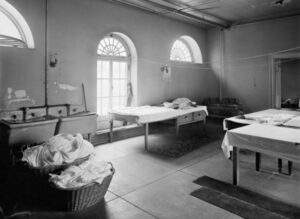
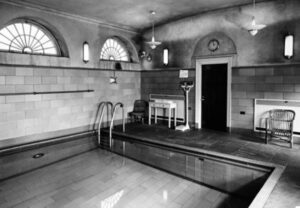 Construction began on the White House on October 13, 1792, and was finally finished on November 1, 1800. Construction was slower in those days, because they didn’t have the equipment we have today. The current White House has 132 rooms. The original White House had 100 rooms. The White House has 54,900 square feet. The White House sits on 18 acres of land. It all it is an impressive building, but there is more to it than just that.
Construction began on the White House on October 13, 1792, and was finally finished on November 1, 1800. Construction was slower in those days, because they didn’t have the equipment we have today. The current White House has 132 rooms. The original White House had 100 rooms. The White House has 54,900 square feet. The White House sits on 18 acres of land. It all it is an impressive building, but there is more to it than just that.
There have been a number of rooms that began as one thing, only to become something else later on. One of the rooms that has had a couple of identities is the Press Briefing Room. These days it is the James S. Brady Press Briefing Room. It was so named after White House Press Secretary James Brady, who was shot and permanently disabled during the assassination attempt on President Reagan. That room, located in the West Wing of the White House was not always such a necessary room, mostly because press briefings are really more of a modern-day thing. The room has always existed, however. In 1909, it was the White House laundry, and during President Truman’s time in office (April 12, 1945 – January 20,1953) it was the White House pool.
By 1950, the White House was 150 years old and in a serious state of disrepair. In order to make is inhabitable 
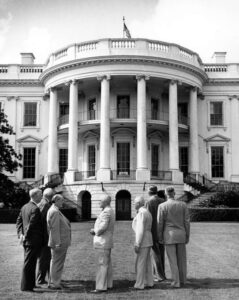 again, the entire building was gutted and rebuilt to make it more stable. It also seemed like a good time to improve on its design, so some improvements and additions were made. White House architect Lorenzo Simmons Winslow designed and built an air raid shelter under the East Terrace on the orders of naval aide Rear Admiral Robert Dennison. There had been a bomb shelter before, but it was built in 1942 and with the invention of the atomic bomb, the old shelter was not strong enough to withstand such an assault. Because little research had been conducted into how to withstand such an assault, construction of the shelter took more than two years and required the removal of the East Terrace entirely. Unfortunately, the 1952 shelter was rendered obsolete when the first test produced a force of 10.4 million tons. This shelter was designed to withstand a force of only 30,000 tons, so this would never work.
again, the entire building was gutted and rebuilt to make it more stable. It also seemed like a good time to improve on its design, so some improvements and additions were made. White House architect Lorenzo Simmons Winslow designed and built an air raid shelter under the East Terrace on the orders of naval aide Rear Admiral Robert Dennison. There had been a bomb shelter before, but it was built in 1942 and with the invention of the atomic bomb, the old shelter was not strong enough to withstand such an assault. Because little research had been conducted into how to withstand such an assault, construction of the shelter took more than two years and required the removal of the East Terrace entirely. Unfortunately, the 1952 shelter was rendered obsolete when the first test produced a force of 10.4 million tons. This shelter was designed to withstand a force of only 30,000 tons, so this would never work.
In addition to the new nuclear shelter, a tunnel was added. These days those tunnels are big in the news, but back then, they were probably a little-known addition. This reinforced concrete channel ran from the West Wing to the East Wing. Though not enough to stop a nuclear incident itself, the tunnel allowed quick passage from one end of the White House to the other, as well as access to the new air raid shelter. The presence of the tunnel demonstrates just how concerned the Truman White House was about securing itself against air assaults at that volatile time in history. That first tunnel inside the White House isn’t the only underground feature. In 1987, a second tunnel was built under the name Project ZP. That tunnel, accessible from a secret passage 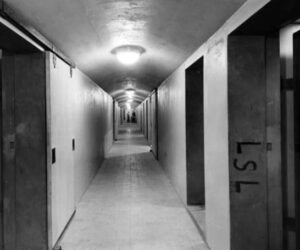
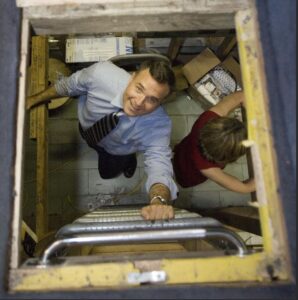 within the Oval Office, leads to the basement of the East Wing and on to the Treasury Building. Its construction, which was largely secret, created a large sinkhole in the White House rose garden. The tunnel was reportedly built to quickly get the president out of the office during an incursion, but it was also used at least once to sneak former president Richard Nixon into a foreign policy meeting. I’m sure there are other changes to the White House, that we are not privy to, and may never know, because there are always secrets in this kind of building.
within the Oval Office, leads to the basement of the East Wing and on to the Treasury Building. Its construction, which was largely secret, created a large sinkhole in the White House rose garden. The tunnel was reportedly built to quickly get the president out of the office during an incursion, but it was also used at least once to sneak former president Richard Nixon into a foreign policy meeting. I’m sure there are other changes to the White House, that we are not privy to, and may never know, because there are always secrets in this kind of building.
 Many people would agree that one of the greatest presidents the United States ever had was Ronald Reagan. He was not what we would consider a career politician, and in fact, most would knw him as an actor long before he was a politician. Nevertheless, after spending time as the President of the Screen Actors’ Guild, where he fought against Communist influence on the screen, Ronald Reagan was elected governor of California in 1966. He then became president in 1980, and the rest, as they say is history, but it is not the end.
Many people would agree that one of the greatest presidents the United States ever had was Ronald Reagan. He was not what we would consider a career politician, and in fact, most would knw him as an actor long before he was a politician. Nevertheless, after spending time as the President of the Screen Actors’ Guild, where he fought against Communist influence on the screen, Ronald Reagan was elected governor of California in 1966. He then became president in 1980, and the rest, as they say is history, but it is not the end.
Ronald Reagan would prove to be a very strong person in many areas of his life…some we know of, and some, maybe not…or at least, I didn’t. After college, where Reagan was an average student, and basically considered a “jack of all trades,” he did some work in radio and such until deciding to enlist in the Army Enlisted Reserve. He was commissioned a second lieutenant in the Officers’ Reserve Corps of the Cavalry on May 25, 1937. On April 18, 1942, Reagan was ordered to active duty, but because of poor eyesight, he was classified for limited service only, which excluded him from serving overseas. His first assignment was at the San Francisco Port of Embarkation at Fort Mason, California, as a liaison officer of the Port and Transportation Office. Upon the approval of the Army Air Forces (AAF), he applied for a transfer from the cavalry to the AAF on May 15, 1942, and was assigned to AAF Public Relations and subsequently to the First Motion Picture Unit (officially, the 18th AAF Base Unit) in Culver City, California. On January 14, 1943, he was promoted to first lieutenant and was sent to the Provisional Task Force Show Unit of “This Is The Army” at Burbank, California. He returned to the First Motion Picture Unit after completing this duty and was promoted to captain on July 22, 1943. While he did not serve in combat, President Reagan was shot. Most of us know that President Reagan survived an assassination attempt on March 30, 1981, when he and his press secretary James Brady were both shot. Also hit by gunfire from would-be assassin John Hinckley Jr outside the Washington Hilton Hotel, were Washington police officer Thomas Delahanty and Secret Service agent Tim McCarthy. President Reagan was “close to death” when he arrived at George Washington University Hospital. He was stabilized in the emergency room, then underwent emergency exploratory surgery. He recovered from his gunshot wound, and was released from the hospital on April 11, becoming the first serving US president to survive being shot in an assassination attempt. President Reagan became very popular after the attempt of his life, with the polls indicating his approval rating to be around 73 percent.
For his part, Reagan believed that God had spared his life so that he “might go on to fulfill a higher purpose.” That is true in my opinion, but it was not the first time Ronald Reagan’s life had been placed at risk. President Reagan attended Dixon High School, where he developed interests in acting, sports, and storytelling, but his first job involved working as a lifeguard at the Rock River in Lowell Park in 1927. He was a life guard there for six years, and during that time, Reagan performed 77 rescues. While much of the rest of his career was highly 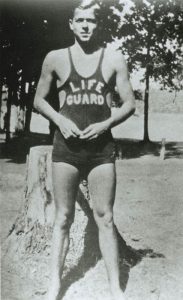 public, and well known by most people, this little tidbit was rather hidden in the archives of his life. I suppose many people thought that his job as a lifeguard was a minor role within the many roles he played in his lifetime, but I doubt if the 77 people whose lives he saved as a lifeguard would consider it to be such a minor role. If you have ever been saved from drowning…and I have…you know that you will never forget that person who saved you. I never knew my rescuer’s name, but to this day, I can see her face. I was a girl of about 10 or 12 maybe, and had no training in swimming, but I had achieved the great height of 5 feet, and thought that meant I could swim in the 5 foot area of the pool, not considering that 5 feet was at the top of my head. Thank God for the girl swimming by, who pushed me to the side of the pool. Needless to say, I taught myself to swim after that, and before summer’s end I had passed my swimming test at the pool. What President Reagan did for those 77 people, was as heroic as any soldier. A flailing victim in danger of drowning can take down their would be rescuer, and then both would likely drown. It takes a special person to put their life at risk to save another, and as in many other areas of his life, President Reagan was a true hero.
public, and well known by most people, this little tidbit was rather hidden in the archives of his life. I suppose many people thought that his job as a lifeguard was a minor role within the many roles he played in his lifetime, but I doubt if the 77 people whose lives he saved as a lifeguard would consider it to be such a minor role. If you have ever been saved from drowning…and I have…you know that you will never forget that person who saved you. I never knew my rescuer’s name, but to this day, I can see her face. I was a girl of about 10 or 12 maybe, and had no training in swimming, but I had achieved the great height of 5 feet, and thought that meant I could swim in the 5 foot area of the pool, not considering that 5 feet was at the top of my head. Thank God for the girl swimming by, who pushed me to the side of the pool. Needless to say, I taught myself to swim after that, and before summer’s end I had passed my swimming test at the pool. What President Reagan did for those 77 people, was as heroic as any soldier. A flailing victim in danger of drowning can take down their would be rescuer, and then both would likely drown. It takes a special person to put their life at risk to save another, and as in many other areas of his life, President Reagan was a true hero.
 Over the course of our nation’s history, we have managed to keep most of our presidents safe. Out of 45 Presidents of the United States, 4 were assassinated, and 6 others were shot while in office, but survived their attacks. Ronald Regan was the last United States President to be shot while in office. Reagan did not immediately realize that he had been shot…something that came as a shock to many. He was rushed to the hospital, where he underwent emergency surgery to remove the bullet and to repair his lung. The president remained in good humor, and he reportedly told his wife Nancy, “Honey, I forgot to duck” (a line first attributed to the boxing heavyweight Jack Dempsey when he lost the title to Gene Tunney in 1926), and to his doctors he said, “Please tell me you’re Republicans.” He was a loyal Conservative all his life.
Over the course of our nation’s history, we have managed to keep most of our presidents safe. Out of 45 Presidents of the United States, 4 were assassinated, and 6 others were shot while in office, but survived their attacks. Ronald Regan was the last United States President to be shot while in office. Reagan did not immediately realize that he had been shot…something that came as a shock to many. He was rushed to the hospital, where he underwent emergency surgery to remove the bullet and to repair his lung. The president remained in good humor, and he reportedly told his wife Nancy, “Honey, I forgot to duck” (a line first attributed to the boxing heavyweight Jack Dempsey when he lost the title to Gene Tunney in 1926), and to his doctors he said, “Please tell me you’re Republicans.” He was a loyal Conservative all his life.
John Hinckley, Jr. was a deranged individual with a crazed obsession for Jody Foster. Hinckley’s path toward the assassination attempt began in 1976 when he saw the movie Taxi Driver. In the movie, Robert DeNiro’s character, Travis Bickle stalks a Presidential candidate in the hopes that he will somehow impress and rescue a young prostitute played by Jodie Foster. Hinckley, who spent seven years in college without earning a degree or making a friend, added Foster to his list of obsessions, which also included Nazis, the Beatles, and assassins. In May 1980, Hinckley wrote to Foster while she attended Yale University, traveled there and talked to her on the phone at least once. Soon after, he began following President Jimmy Carter. In October, he was arrested at airport near a Carter campaign stop for carrying guns. However, the Secret Service was not notified. Hinckley  simply went to a pawnshop in Dallas and bought more guns. For the next several months, Hinckley’s plans changed daily. He pondered kidnapping Foster, considered killing Senator Edward Kennedy and began stalking newly elected President Reagan. Finally, he wrote a letter to Foster explaining that his attempt on Reagan’s life was for her. He kept abreast of the president’s schedule by reading the newspaper.
simply went to a pawnshop in Dallas and bought more guns. For the next several months, Hinckley’s plans changed daily. He pondered kidnapping Foster, considered killing Senator Edward Kennedy and began stalking newly elected President Reagan. Finally, he wrote a letter to Foster explaining that his attempt on Reagan’s life was for her. He kept abreast of the president’s schedule by reading the newspaper.
On March 30, 1981, Hinckley decided that he had found the perfect opportunity, and it turns out that he was right. Normally the President wears a bullet proof vest when entering and exiting engagements, but as it was only 30 feet to the limo, it was deemed unnecessary. Bad idea. Reagan stepped outside the Hilton Hotel in Washington D.C. where he had just addressed the Building and Construction Workers Union of the AFL-CIO. Hinckley was armed with a .22 revolver with exploding bullets and was only ten feet away from Reagan when he began shooting. Fortunately, he was a poor shot and most of the bullets did not explode as they were supposed to. Hinckley’s first shot hit press secretary James Brady in the head, critically wounding him, and other shots wounded a police officer and a Secret Service agent. The final shot hit Reagan’s limo and then ricocheted into the President’s chest. Hinckley had completely missed 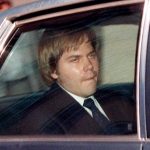 Reagan, but “got lucky” when the bullet ricocheted. How he managed that is beyond the imagination, and not so “lucky” for President Reagan who, as he said, “Forgot to duck.” I also find it amazing that President Reagan could keep his sense of humor. It shows me what a man of grit he really was.
Reagan, but “got lucky” when the bullet ricocheted. How he managed that is beyond the imagination, and not so “lucky” for President Reagan who, as he said, “Forgot to duck.” I also find it amazing that President Reagan could keep his sense of humor. It shows me what a man of grit he really was.
Hinckley was also wounded police officer Thomas Delahanty and Secret Service agent Timothy McCarthy. All of the shooting victims survived, although Brady’s 2014 death was later ruled a homicide 33 years after he was shot. Hinckley was later not found not guilty by reason of insanity. Hinckley was released from institutional psychiatric care on September 10, 2016, which I find astonishing. He currently lives with his mother.
 After the March 5, 1946, speech by former British Prime Minister Winston Spencer Churchill, condemning the Soviet Union’s policies in Europe, in which he declared, “From Stettin in the Baltic to Trieste in the Adriatic, an iron curtain has descended across the continent.” It was basically the opening remark that defined the Cold War years, and everyone knew that Russia could not be trusted. I suppose that they were similar to the North Koreans today. The Cold War would continue for the next 45 years. It was a source of concern for a number of United States Presidents over the years, as well as the American people. President Ronald Reagan was one of those presidents.
After the March 5, 1946, speech by former British Prime Minister Winston Spencer Churchill, condemning the Soviet Union’s policies in Europe, in which he declared, “From Stettin in the Baltic to Trieste in the Adriatic, an iron curtain has descended across the continent.” It was basically the opening remark that defined the Cold War years, and everyone knew that Russia could not be trusted. I suppose that they were similar to the North Koreans today. The Cold War would continue for the next 45 years. It was a source of concern for a number of United States Presidents over the years, as well as the American people. President Ronald Reagan was one of those presidents.
On March 8, 1983, while speaking at a convention of the National Association of Evangelicals in Florida, President Ronald Reagan publicly referred to the Soviet Union as an evil empire. It was the second time in his career that President Reagan had made this reference. He had first used the phrase in a 1982 speech at the British House of Commons. Some considered Reagan’s use of the Star Wars film-inspired terminology to be brilliant democratic rhetoric, but then in my opinion there was little about President Reagan that wasn’t brilliant. Of course, there were those within the international diplomatic community who denounced it as irresponsible bombast…typical remarks from those who would appease their enemies, thinking that it would stave off any attack. Most evil nations think of appeasement as a show of weakness…and it doesn’t do much for how the citizens of the good nations feel about their own safety either.
President Reagan was prepared to take an aggressive stance toward the Soviet Union. In his plan, known as the 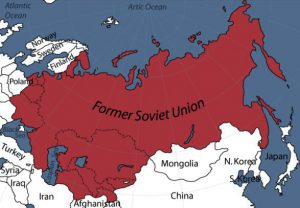 Reagan Doctrine, he warned the nations of the world against what he saw as the dangerous trend of tolerating the Soviets build-up of nuclear weapons and attempts to infiltrate Third World countries in order to spread communism. President Reagan’s policy was basically peace through strength. We had to make the Soviets understand that we would never compromise our principles and standards, nor ignore the facts of history and the aggressive impulses of an evil empire. To do so would mean abandoning the struggle between right and wrong and good and evil, and he knew that must never happen. I think we, the nations of the world, have seen just how detrimental a weak security stance can be given the current mess we are digging out of.
Reagan Doctrine, he warned the nations of the world against what he saw as the dangerous trend of tolerating the Soviets build-up of nuclear weapons and attempts to infiltrate Third World countries in order to spread communism. President Reagan’s policy was basically peace through strength. We had to make the Soviets understand that we would never compromise our principles and standards, nor ignore the facts of history and the aggressive impulses of an evil empire. To do so would mean abandoning the struggle between right and wrong and good and evil, and he knew that must never happen. I think we, the nations of the world, have seen just how detrimental a weak security stance can be given the current mess we are digging out of.
Reagan proposed a policy that went beyond the Truman Doctrine of containment, urging active intervention. His plan was to increase United States military spending and, if necessary, to use force to roll back communist expansion in Third World nations. His administration provided military aid to Nicaraguan groups fighting the leftist Sandinista government and gave material support to the Afghan mujahedeen in their ongoing war against Soviets. At the same time, he reassured Americans that he would pursue an understanding with totalitarian powers and cited the United States’ effort to limit missile development as a step toward peace. Reagan’s doctrine came at the same time as a surge in international and domestic protests against the United States-Soviet arms 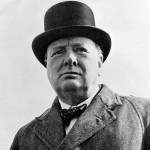 race. His opponents blamed the administration for causing the largest increase in American military spending since the beginning of the Cold War, a policy that swelled the nation’s budget deficit. I suppose that those who just look at the money, might think this was a bad thing, but in the late 1980s the Soviet Union collapsed, ending decades of communist rule in Russia and Eastern Europe. There were those who believed that it had collapsed under the weight of its own bloated defense spending and a protracted war in Afghanistan, but Reagan and his supporters credited his hard-line anti-communist policies for defeating Soviet communism. I am inclined to agree with President Reagan, because I have never believed that we can appease our way to peace and safety in this world.
race. His opponents blamed the administration for causing the largest increase in American military spending since the beginning of the Cold War, a policy that swelled the nation’s budget deficit. I suppose that those who just look at the money, might think this was a bad thing, but in the late 1980s the Soviet Union collapsed, ending decades of communist rule in Russia and Eastern Europe. There were those who believed that it had collapsed under the weight of its own bloated defense spending and a protracted war in Afghanistan, but Reagan and his supporters credited his hard-line anti-communist policies for defeating Soviet communism. I am inclined to agree with President Reagan, because I have never believed that we can appease our way to peace and safety in this world.

